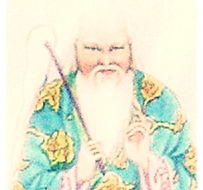
Worship
Rituals
Prayers
Liturgical Calendar
The
Great
Faith
of
the
Third
Universal
Amnesty

God
and
Humanity
Love
and
Justice
Bibliography & References

The Cao Đài Emblem
From the left:
-
The Duster of Taoism
-
The Alms Bowl of Buddhism
-
The Spring & Autumn Annals of Confucianism

His Holiness Confucius - The Founder of Confucianism


His Holiness Gautama Buddha - The Founder of Buddhism
His Holiness Laozi -
The Founder of Taoism
Unifying Principles
The doctrine of the Cao Đài Religion tends not only to reconcile all religious views, but also to adapt itself to all degrees of spiritual evolution. A basic principle of Caodaism is "All Religions are One".
-
From a moral point of view, the Cao Đài Religion reminds people of their duties towards themselves, their family, their society (a broader family), then toward humanity (the universal family).
-
From a philosophical point of view, Cao Đài Religion preaches renunciation of honors, riches and luxury, in other words, deliverance from servitude to materialism in the attainment of full spiritual quietude of soul.
-
From the point of view of worship, Cao Đài Religion recommends the adoration of God, the veneration of Divine Beings and the worship of ancestors.
-
From a spiritual point of view, Cao Đài Religion confirms, in harmony with other religions, the existence of the spirit, their survival beyond the physical body, and their evolution by successive reincarnations, according to the Karmic Law.
-
From the initiates' point of view, Cao Đài Religion communicates to worthy adherents and reveals teachings that enable them, by a process of spiritual evolution, to reach lasting joy and happiness.
A basic principle of Cao Đài Religion consists in synthesising the Doctrines of the three main Religions - Buddhism, Taoism, and Confucianism - into one. This is why in belonging to Cao Đài Religion, believers must observe the basic principles of these three Religions to cultivate and purify themselves by strictly pursuing the followings:
-
The three main duties and five essential virtues of Confucianism. The three main duties (Tam-Cang) are social relationships between king and subject (quân-thần cang), father and children (phụ-tử cang), husband and wife (phu-thê cang). And the five essential virtues (Ngũ Thường) are: Love/Humanity (Nhơn), Justice/ Righteouness (Nghĩa), Good behaviors/ Politeness (Lễ), Wisdom (Trí), and Loyalty (Tín).
-
The three refuges and the five prohibitions of Buddhism. The three refuges (Tam Qui) are: to take refuge in the Buddha (Qui Y Phật), to take refuge in His Law/ Dharma (Qui Y Pháp), and to take refuge in the Spiritual Community (Qui Y Tăng). The five prohibitions (Ngũ Giới) are: no killing (sát sanh), no stealing (du đạo), no obscenity (tà dâm), no intoxicants (tửu nhục), and no lying (vọng ngữ).
-
The striving to unify the three jewels and the five elements of Taoism. The three jewels (Tam Bửu) are: life matter/ jing (tinh), life energy/ qi (khí), and soul/ shen (thần). The five elements (Ngũ Hành) are: metal (kim), vegetable/wood (mộc), water (thủy), fire (hỏa), and earth (thổ).